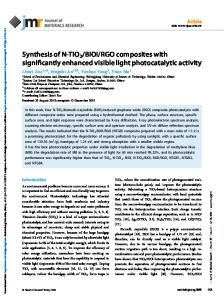1D porous C 3 N 4 /rGO composites with enhanced photocatalytic nitrogen fixation performance
- PDF / 2,888,577 Bytes
- 10 Pages / 595.276 x 790.866 pts Page_size
- 56 Downloads / 334 Views
1D porous C3N4/rGO composites with enhanced photocatalytic nitrogen fixation performance Xulan Yang1, Huixian Liu1, Chenglong Wang1, Xuyun Li1, Longjun Liang1, and Zuwei Song1,* 1
College of Chemistry and Pharmaceutical Sciences, Qingdao Agricultural University, Qingdao 266109, China
Received: 19 July 2020
ABSTRACT
Accepted: 11 September 2020
A modified thermal polycondensation method is developed to fabricate 1D porous C3N4/rGO (P-CN/rGO) composites using melamine and graphene oxide (GO) as raw materials. The resultant P-CN/rGO with specific surface area of 87.533 m2 g-1 shows an excellent photocatalytic nitrogen fixation performance. The NH3 yield rate of P-CN/rGO reaches to 9.8 mg L-1 h-1 gcat-1 under visible-light irradiation, which is 11.8 times greater in comparison with bulk C3N4 used alone. Such superior photocatalytic activity should be ascribed to the unique features of P-CN and the introduction of rGO. The 1D porous rod-like structure of P-CN provides a large number of active sites to activate N2 molecules and facilitate rapid charge transfer. The coupled rGO serves as co-catalyst to expand the light-harvest region of the composite from the ultraviolet to the visible-light region. Besides, it is disclosed that the high conductivity of rGO can facilitate the migration of photogenerated electrons from the photocatalyst to N2, thus preventing the electron–hole recombination and significantly ameliorating the photocatalytic nitrogen fixation performance. A reasonable photocatalytic mechanism is also proposed.
Ó
Springer Science+Business
Media, LLC, part of Springer Nature 2020
1 Introduction Nitrogen fixation is the second most important chemical process in nature next to photosynthesis [1]. Ammonia, one of the nitrogen-fixing products, is an important raw material for various chemical products, pesticides, fertilizers and hydrogen storage materials [2]. At present, the Haber–Bosch process was mainly adopted to produce ammonia at 673–873 K and pressure of 15–25 MPa [3]. Obviously,
Address correspondence to E-mail: [email protected]
https://doi.org/10.1007/s10854-020-04491-4
large energy consumption is inevitable, and environmental pollution resulting from the carbon emissions still exists [4]. Therefore, it is essential to develop a milder, green and low energy consumption process under artificial nitrogen fixation. In 1977, Fedoped TiO2 catalyst was first used to reduce N2 under UV light irradiation [5]. Since then, photocatalytic nitrogen fixation is considered to be a new technology that can replace the Haber–Bosch process. Whereby many semiconductor photocatalysts have been reported for photocatalytic nitrogen fixation
J Mater Sci: Mater Electron
under ultraviolet or visible light, comprising TiO2, CdS, Fe2O3 and so on [6–9]. Graphitic carbon nitride (g-C3N4) is a novel metalfree photocatalyst and has been widely used in the fields of photogenerated cathodic protection, organics degradation and electrocatalysis owing to its moderate bandgap energy, simple synthesis, visiblelight response
Data Loading...











